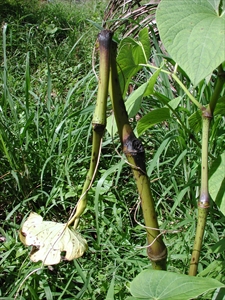Kava dieback
Pacific Pests, Pathogens, Weeds & Pesticides - Online edition
Pacific Pests, Pathogens, Weeds & Pesticides
Kava dieback (160)
Cucumber mosaic virus causes kava dieback; the abbreviation is CMV.
Worldwide. Cucumber mosaic virus has been recorded in kava causing dieback from Cook Islands, French Polynesia, Fiji, Palau, Samoa, Tonga, and Vanuatu.
A virus with a large host range. It is especially common in the families Curbitaceae, Fabaceae and Solanaceae. In Pacific islands, the following crops are common hosts: kava, banana, cantaloupe melon, capsicum, chilli, pumpkin, snake gourd, tomato and watermelon. Cucumber mosaic virus has also been found in weeds, e.g., Ruellia, Synedrella, Mikania and Commelina.
The first sign of the disease is young leaves with sharply defined patches of yellow or white (Photo 1). This is called a mosaic symptom, and it usually occurs together with leaf distortions, such as a crinkling or puckering along the veins (Photos 1&2). If the stems of these leaves are cut, brown lines are seen inside. This is the start of the black soft rot of the stems (Photo 3).
Cycles of dieback and regrowth often occur before the plant dies. Very occasionally, the leaves on diseased plants also wilt.
Aphids spread CMV, the virus that causes kava dieback. This can happen very quickly. As the aphids feed on diseased plants they pick up the virus with their mouthparts. If they fly to healthy plants and feed again, those plants become infected. The melon or cotton aphid (Aphis gossypii) is common on kava as well as on many other crops and weeds. The virus is also spread when cuttings from infected plants are used for propagation.
This is a very serious disease. Losses are high in all the major kava-growing countries.
Look for leaves that have mosaic patterns and distortions. Look for early signs of stem rot at tips or at lower nodes (the swollen part of the stem from where the leaves grow).
CULTURAL CONTROL
Cultural control is the only way to manage kava dieback:
Before planting:
- Site: Plant kava in small isolated plantings below a tree canopy. The soil must be well drained, fertile and high in organic matter; strong, healthy plants are probably better at resisting the disease, and/or recovering from infection.
- Use healthy planting material: Take cuttings from healthy plants. NEVER use cuttings from a diseased plant, even if part of the plant looks healthy. Be careful not to choose plants that died back previously and have regrown and look healthy. It is best to take cuttings only from plantations that have never shown signs of the disease.
- Nursery the cuttings: Grow cuttings in a nursery to produce young fast-growing healthy plants. Check each plant for disease symptoms before taking it to the field at about 3 months. Destroy diseased plants.
During growth:
- Remove weeds: Keep gardens free from weeds, especially Commelina (called dayflowers) and Mikania (called mile-a-minute) that are common hosts of CMV. Note, Mikania does not show symptoms when infected.
- Follow traditional methods: Grow kava in a traditional garden; that is, plant crops that are not good hosts of CMV under tall trees. This increases the chance that aphids with CMV will land on these plants and lose the virus from their mouthparts as they feed before moving to feed on kava. Crops that are not good hosts of CMV include taro and its relatives, Abelmoschus (bele) cabbage, banana, cassava, citrus, papaya, sugarcane and yams. Do not grow kava with cucurbits (pumpkin, squash and watermelon), solanaceous crops (tomato, tobacco, capsicum, chilli, eggplant and others), legumes (snake bean and peanuts), passionfruit, pineapple and Erythrina trees. These are all hosts of CMV.
- Pruning: Check the plants carefully each week. Look for diseased leaves; if found:
- Break off the stem at the first node above the ground. Do not cut it with a knife, as the knife can spread the virus.
- Collect the stems and any leaves, put them in a bag, take them out of the plantation and burn or bury them.
- Note, this method works best on plants over 1-year-old; if diseased plants are younger it is best to dig them out and replace them with fresh cuttings.
After harvest:
- Collect and burn leaves, stems and other debris.
RESISTANT VARIETIES
There is no known resistance among the varieties of kava grown in Fiji, Samoa and Tonga.
CHEMICAL CONTROL
Chemical control is not appropriate for this disease. There are no chemicals that can rid plants of virus, and although many insecticides kill aphids, they cannot kill them before they feed and spread the virus.
AUTHOR Grahame Jackson & Richard Davis
Information from (including Photos 1-3) Davis RI (2005) Kava dieback. Plant Advisory Leaflet No. 47. Secretariat of the Pacific Community. Quality Print, Suva, Fiji Islands; and Davis RI et al. (2005) Cucumber mosaic virus infection of kava (Piper methysticum) and implications for cultural control of kava dieback disease. Australasian Plant Pathology 34: 377-384. (https://link.springer.com/article/10.1071/AP05050; and from Mereia Fong-Lomavatu et al. (2006) Yaqona dieback disease management: A package of practice. Koronivia Research Station, Ministry of Primary Industries, Fiji Islands.
Produced with support from the Australian Centre for International Agricultural Research under project PC/2010/090: Strengthening integrated crop management research in the Pacific Islands in support of sustainable intensification of high-value crop production, implemented by the University of Queensland and the Secretariat of the Pacific Community.






